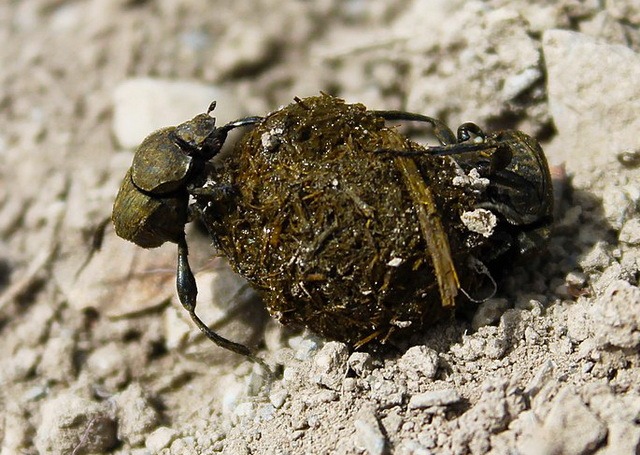Dung ball roller female helps male when things get difficult

Together, a male and female dung ball roller are able to transport a dung ball over a path with obstacles. He leads, she moves along and assists where necessary, Claudia Tocco and colleagues show.
Dung ball rollers (Sisyphus species) have a striking habit. The dung beetles form pairs, take a piece of mammal droppings, construct a ball larger than themselves and roll it away in a straight line to make sure not to collide with other pairs that have taken a part of the same dung pile. When, often after demanding work, they arrive at a suitable place, they bury their ball in the soil together with an egg. The larva that will hatch from the egg is surrounded by excellent food.
Claudia Tocco and colleagues wanted to know more about the harmonious cooperation that male and female exhibit. They investigated how partners divide tasks in two species: Sisyphus fasciculatus from South Africa and Sisyphus schaefferi, that lives in North Africa, Southern Europe, and Asia Minor. In an outdoor test setup, they offered cow dung to groups of dung ball rollers. The beetles formed pairs, constructed a dung ball and started rolling.
Backwards
The male, which is slightly larger than the female, is always the one driving the dung ball transport, as the researchers saw. He determines the course. He walks backwards and pulls the dung ball with his front legs. His partner walks on the other side, also backwards, with her head down and her hind legs on the ball. On flat terrain, she contributes nothing. If the male stops rolling, she also stops. So, you never see a female dragging a dung ball by herself. Conversely: if she stops, he goes on alone, rolling the dung ball as quickly and staying on course as well as a couple.
Mostly, she does move along, maintaining contact with the ball. Consequently, she can help immediately when things get difficult. And they do, because Sisyphus fasciculatus and Sisyphus schaefferi live in woodlands and forests, with all kinds of objects lying on the ground. A couple of dung ball rollers often encounters obstacles. The researchers conducted experiments to simulate these situations to see how the pair cleared them.
First, they placed two 2.6 centimeter high obstacles one behind the other on the path. That is quite a challenge, because a dung ball roller is less than a centimeter long. At these obstacles, the female no longer followed passively, as it turned out, but assisted by pushing or steering, and as a result, a pair cleared the double obstacle faster than a male working alone. Moreover, a male alone often gave up.
Climbing
In a next series of experiments, the beetles were challenged with a wall of 3.9, 6.5 or 9.1 centimeters high. The higher the wall, the less likely a pair was to climb over it with the ball and the less likely it was to succeed if it tried. A male alone declined more often than a pair, but if he tried to clamber over the wall, he usually succeeded.
A couple could get over a high obstacle faster than a male alone, mainly because the female helped at the start. When the male pulled himself up along the wall and lifted the dung ball from the ground, she stabilized the ball with her hind legs and pushed it, in a headstand position. Then he worked his way up, while she hung on the ball. Despite that extra burden for the male, a pair climbed as quickly as a male alone. If he was in danger of falling, she would provide support. Once she got to the top, she became active and pushed the ball over the edge with her head. The beetles then fell down and continued their path.
Punishment
Dung ball rollers manage to get their ball over difficult obstacles. Unlike the Greek mythical king Sisyphus, after whom the beetles are named. Because of his brutality towards the gods, he was punished by having to push a boulder up a slope in the underworld for eternity, while the boulder kept falling back. He could not do it alone and he did not have a partner to lend a hand.
Willy van Strien
Photo: Sisyphus schaefferi couple with dung ball, male at left side, female at right side. Daniel Ballmer (Wikimedia Commons, Creative Commons, CC BY-SA 4.0)
Watch the dung beetles’ behaviour on YouTube
Sources:
Tocco, C., M. Byrne, Y. Gagnon, E. Dirlik & M. Dacke, 2024. Spider dung beetles: coordinated cooperative transport without a predefined destination. Proceedings of the Royal Society B 291: 20232621. Doi: 10.1098/rspb.2023.2621
Dacke, M., E. Baird, B. el Jundi, E.J. Warrant & M. Byrne, 2021. How dung beetles steer straight. Annual Review of Entomology 66: 243-256. Doi: 10.1146/annurev-ento-042020-102149